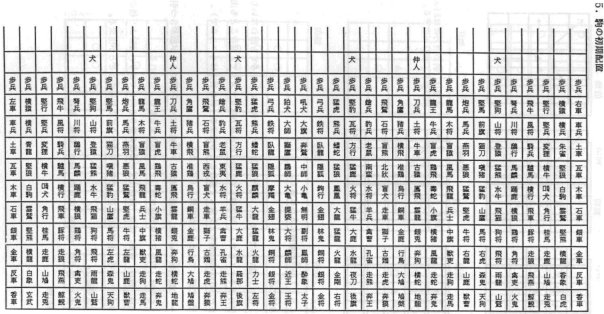Tai Kyoku Shogi (Ultimate Shogi)
This ancient Shogi is even bigger than Tai Shogi. Tai Kyoku Shogi is tremendously enormous with 804 pieces battling over a 36x36 board.
Until recently, it was taken for almost a legend. But now, experts are convinced that he had really existed. Details about its rules have been found. However, there are several inconsistencies which need more work.

Yes, Tai Kyoku Shogi exists !

Starting position (from Sekai no Shogi by
Isao Umebayashi)
SHORT DESCRIPTION:
The board is a 36X36 grid, with 11 ranks for each player's position. There are 402 pieces in each camp and the players have to remember 300 different moves!
The reconstruction of rules is a work still in progress. Only few elements are known, and among them, many need further clarification.
It seems that contrarily to other very large Shogi variants, promotion was not obtained at first capture but upon reaching any of the opponent's 11 ranks.
Captured pieces are removed from play, there were no drops.
Free Eagle is able to capture without moving (igui) an adjacent square.
Great General, Vice General, Rook General, Bishop General, Violent Dragon, Flying Crocodile are equal to their counterparts in Tenjiku Shogi. The pieces are able to leap over others according to rank. By jumping over any number of lower ranked pieces, including friend and foe, continuing until making a capture. This is the ranking of these pieces:
-
(1) King, Crown Prince
-
(2) Great General
-
(3) Vice General
-
(4) Bishop General, Rook General, Violent Dragon, Flying Crocodile
-
(5) the other pieces
More will be posted here if the reconstruction progresses.
HISTORY and recent developments:
The Shogi Zushiki, published before the end of the 17th century, mentioned the huge Taikyoku Shogi. The great English specialist, George Hodges affirms that three different sources detail Tai Kyoku Shogi. Not surprisingly it is assumed that priests invented this game too.
Few years ago (1999), raw scans from Sekai no Shogi by Isao Umebayashi, a Japanese book about Shogi variants, published in 1997 by Shogi Tengokusha were made available on the Internet. They correspond to 34 pages in Japanese giving diagrams and some explanations of the moves of the various pieces. What were the author's sources is not known.
Those pages have been translated into English, studied and commented by a group of enthusiast players who are active on the "Shogivar" club on Yahoo. The work has been compiled by L. Lynn Smith with essential contributions from Patrick Davin, Luke Merrit, Colin Paul Adams, Michael Vanier and others in discussion groups. This page has mainly be constructed from their results and there are deeply acknowledged.
Finally, on June 19, 2003, George Hodges sent an important message to the Yahoo club which deserves to be published here:
|
Regarding recent discussions on Tai Kyoku Shogi, it is not correct to think that this game is the latest of the variants by any means. The most recent research in Japan (late last year), summarised in an appendix to my "Ten Shogi Variants" publication, which deals with this variant over some 36 pages, all in diagram form, would seem to indicate a date for Tai Kyoku Shogi of around 1650 (early Edo times). It is indeed relatively unlikely that promotion was at the 11th rank and this is possibly a typically rash and unjustified assumption made by modern writers, who might not have realised or remembered that in the larger variants, promotion is normally by capture. It is, however, at least possible, that promotion at the Pawn line was indeed the case. Regrettably, there are a very large number of other currently insoluble difficulties with this variant: Very many of the names of the pieces are now known to be quite wrong; likewise many of the moves of the pieces are also believed to be totally wrong. Consider, for example, that no fewer than 57 pieces, well known from other connected variants, are given with a quite different move! Three ancient sources are now known (as at November 2002), with numerous differences in names and moves; no two of them agree! Much more research needs to be done if one is ever going to arrive at anything like an historically, reasonably based set of names, moves and rules. Apparently the board used for this variant was, in actual fact, very much smaller than the normal Shogi dimensions nowadays and therefore, the piece-names needed to be brush-written in extremely small logographs. This is just one aspect that has no doubt led to wrong names. One should bear in mind that many of the kanji employed on these pieces were, even at that time, very obscure names (couldn't be easily read with certainty) and thereby wrong moves were conjectured. For example, in a simple possibility as applied to some pieces: "Is this a vertical whatever (e.g. Tiger) piece? - they move vertically - if not, then it isn't and it doesn't - so what is it and how does it move?!! There is no doubt that very much more research on Tai Kyoku Shogi is needed in Japan, by experts who understand linguistic and Shogi variant historical aspects sufficiently well to make reasoned judgements, before anything worthwhile can hope to emerge with this little boardgame! George Hodges, June 19, 2003 |






